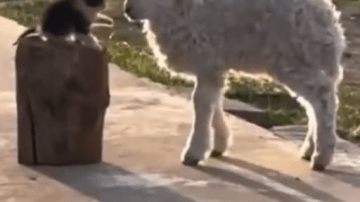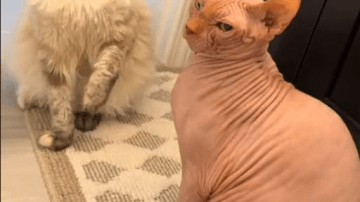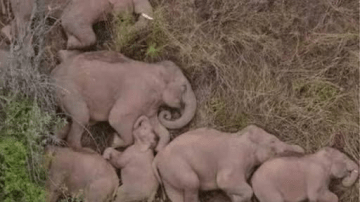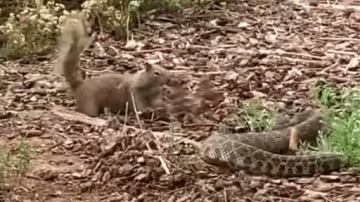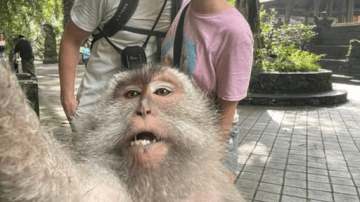The African dawn was just breaking when rangers discovered her—small, fragile, and trembling in the tall grass. The newborn rhino calf was barely a few hours old, her gray skin still glistening with birth. She cried softly, a lonely, desperate sound that echoed through the savanna. Her mother was gone—lost to poachers who had come under cover of night, leaving behind only silence.
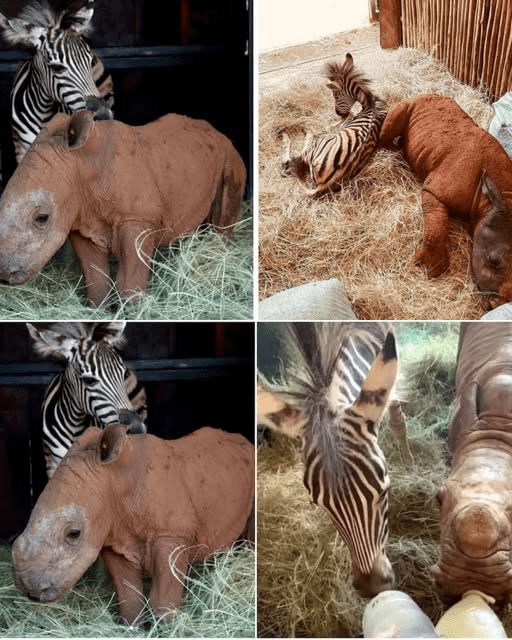
Her rescuers named her Daisy.
At just a few hours old, Daisy was weak, dehydrated, and terrified. Her heartbeat was erratic, her breathing shallow. Every few seconds, she called out—soft, broken cries that no one answered. The rangers moved quickly, wrapping her in blankets and driving her through the early morning mist toward Care for Wild Rhino Sanctuary, the world’s largest rhino orphanage, hidden deep in the heart of South Africa’s wilderness.
No one knew if she would survive the night.
The Battle to Save Daisy
When Daisy arrived at the sanctuary’s intensive care unit, the veterinarians sprang into action. She was dangerously cold and suffering from severe umbilical infection. Her body temperature was dropping fast.
For hours, caretakers worked in shifts, rubbing her skin to stimulate warmth, wrapping her in heated blankets, and inserting IV lines to deliver life-saving fluids and antibiotics. Her body trembled from exhaustion.
“She was so small and fragile,” recalled one caretaker. “We didn’t think she’d make it through the first 24 hours. But there was a spark in her eyes—a tiny will to live.”
That spark was enough for them to keep going.
They gave her milk every two hours, sometimes through the night. They talked to her softly, calling her name, letting her know she wasn’t alone. Daisy began to stabilize, but something in her eyes remained distant.
She wasn’t just fighting to live—she was longing to belong.
The Loneliness of Survival
Despite the warmth and care, Daisy refused to settle. She often called out in the dark, small, aching noises that sounded like she was searching for her mother. She would press her nose against the enclosure wall, as if hoping for an answer.
Caretakers noticed her restless behavior. She was healing physically but not emotionally. Like many orphaned animals, Daisy was suffering from separation trauma.
That’s when fate intervened.
Just a few days before Daisy’s rescue, another orphan had been brought into the same ICU—a tiny zebra foal named Modjadji. She had been found barely alive after a violent thunderstorm, separated from her herd and too young to survive on her own.
The two orphans, both fragile and alone, were fighting parallel battles for survival. And soon, their paths would cross.
The Moment They Met
One afternoon, a caretaker decided to introduce Daisy and Modjadji, hoping companionship might help calm them both. At first, the two animals were cautious. Daisy sniffed the air, her small ears twitching. Modjadji, trembling slightly, took a hesitant step closer.
They studied each other for a long moment—two lost souls who somehow recognized their shared pain.
Then something beautiful happened.
Modjadji reached out and gently brushed her nose against Daisy’s cheek. Daisy didn’t move at first. But when she felt the touch, she leaned closer. What began as cautious curiosity turned into comfort. Within minutes, they were nudging each other softly, exploring each other’s scent, and finally resting side by side.
It was as if they had both decided, without words: You’re my family now.
Healing Through Friendship
Over the next few days, Daisy and Modjadji became inseparable. When the caretakers fed Daisy her milk bottles, Modjadji would stand close by, watching protectively. When Daisy was taken outside for sun therapy, Modjadji followed her closely, their small shadows moving side by side under the African sun.
At night, when the sanctuary grew quiet and the stars filled the sky, the two would lie down together, Daisy curling her heavy head near Modjadji’s striped body. The sound of Modjadji’s slow breathing seemed to lull Daisy to sleep.
Caretakers noticed something extraordinary—Daisy’s recovery accelerated. She began to eat better, sleep deeper, and show more energy. Her tail wagged playfully for the first time. Modjadji, too, grew stronger. She followed Daisy everywhere, as if watching over her.
Their friendship wasn’t just heartwarming—it was healing.
| Stage of Recovery | Daisy (Rhino Calf) | Modjadji (Zebra Foal) | Emotional Impact |
|---|---|---|---|
| Arrival | Weak, dehydrated, traumatized | Injured, hypothermic, fearful | Both withdrawn |
| Week 1 | Responding to care, restless at night | Regaining mobility | Curious toward each other |
| Week 2 | Stable vitals, first signs of play | Begins eating independently | Form bond through gentle contact |
| Month 1 | Gaining strength and confidence | Follows Daisy constantly | Emotional healing visible in both |
The Language of Love
Caretakers often watched in awe as Daisy and Modjadji interacted. Despite being two different species, their communication seemed effortless. They nudged, chirped, and responded to each other’s sounds and body language with surprising understanding.
It reminded everyone that love doesn’t need translation—it just needs presence.
“There’s something pure about how they care for each other,” one caretaker said. “When Daisy is anxious, Modjadji stays near her. When Modjadji rests, Daisy guards her. They’ve become sisters in every sense.”
Their bond began to draw attention across the world. Photos of the baby rhino and zebra sleeping together went viral, touching millions. Messages poured in from people who said the pair gave them hope—a reminder that healing can come from the most unexpected friendships.
Lessons from Daisy and Modjadji
Their story became a living metaphor for resilience, empathy, and the power of connection. The sanctuary staff often said that while they were saving Daisy and Modjadji, the two animals were also saving them—reminding them of why compassion matters.
Here are the lessons their friendship teaches us:
- Love transcends difference. A rhino and a zebra may come from different worlds, but their bond proves connection is universal.
- Healing begins with belonging. Daisy’s recovery truly began when she found emotional companionship, not just medicine.
- Grief can turn into growth. Both lost their mothers, yet found strength in shared love.
- Compassion is contagious. Their story inspired people worldwide to support wildlife conservation.
- Nature reflects humanity. Even in the wild, kindness and empathy can bridge every gap.
- Every act of care ripples outward. Saving one animal can inspire countless others to act with love.
Preparing for the Future
As the months passed, Daisy grew into a strong, healthy young rhino. Her horn began to form, her steps steadier each day. Modjadji, too, matured into a sleek, fast zebra, her stripes glistening in the sun.
Caretakers knew that one day, both would return to the wild. Daisy would join a protected rhino reserve, and Modjadji would be reintroduced to a zebra herd. But separating them would be one of the hardest days the sanctuary had ever faced.
Until then, they were inseparable—two hearts that had turned tragedy into triumph.
When caretakers watched them run across the field, Daisy’s gray bulk beside Modjadji’s striped elegance, they saw something symbolic: strength and freedom moving in harmony.
A Story That Touched the World
Daisy and Modjadji’s unlikely friendship reached far beyond South Africa. Wildlife organizations used their story to raise awareness about poaching, habitat loss, and the emotional lives of animals. Schools shared their journey as a lesson in empathy and coexistence.
Children wrote letters to the sanctuary saying things like, “I want to be like Modjadji and Daisy—kind to everyone, even if they’re different.”
It was proof that sometimes, one friendship can change the world more than a thousand speeches ever could.
Final Thought
In the heart of South Africa, two orphans—one covered in stripes, the other in gray folds of skin—found something extraordinary: family.
They had every reason to give up. But instead, they chose to love.
Daisy and Modjadji remind us that healing isn’t just about survival—it’s about connection. It’s about finding warmth in another’s presence, even when the world feels cold.
One day, Daisy will return to the wild, strong and fearless, and Modjadji will run free with her herd. But their story will live on, reminding us that love knows no boundaries—and sometimes, the family you find is the one that saves you.
This article is for inspirational and educational purposes, celebrating animal compassion and reminding us of the beauty that exists when we choose to care for one another—no matter the species.

